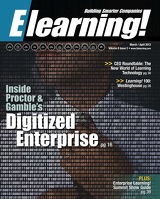Elearning! Magazine: Building Smarter Companies via Learning & Workplace Technologies.
Page 32 of 52
bravenewlearningworld "The training/learning function is also
going outside of the employee base. More and more projects are organized around channels: supply side, manufac- turing, dealerships, franchises. They are much broader than employee- or HR- focused projects. "We also have seen trends move away
from top-down, very structured, formal training to social or bottom-up training pro- grams and activities. A lot of social learning and community-based learning is taking place. We've also seen a shift from more for- mal activities to more informal activities: mentoring, coaching and really embedding expertise to different training programs that create more informal activities."
they didn't want adults mucking it up. We were trying to communicate with them through emails, and the response was zero. The moment you send out a text message — or even better yet put it on Facebook — we opened up whole new communication channels. The way in which younger peo- ple communicate and learn is fundamen- tally different from the way we did it, even though we were shakers and movers."
RUSSELL: "In the old days — 10 years ago — the job of the data center operators and the I.T. officers were to protect and secure the assets and control the environ- ment. In this day of device and social- media explosion, they can no longer con-
'There has to be a magic
balance between top-down and bottom-up.'
—Frank Russell, CEO, Prositions
RUSSELL: "We see organizations mov- ing to a concept-building broad architec- ture for people analytics. The future is in 'app-lification': building lightweight apps that can run on devices socially enabled to sit on top of a social learning fabric that reports back to an enterprise 'warehouse' for people analytic solutions. "A lot of organizations are asking how to
evolve to a talent management structure so that recruiting systems, applicant tracking systems, learning development, perform- ance management and coaching, in order to provide managers the intelligence to know what they're supposed to do every day to develop and nurture people, to retain peo- ple, and to attract the right people. "There's a lot more opportunity for
sophistication around people analytics. Think of that as a sort of heavy back-end piece and the app-lification as the light- weight piece. You'll see lighter tools for quizzes, assessments, testing, learning and content-imbedded systems." TODD: "As an example, we were involved in a project where students owned it, and
32 March / April 2012 Elearning!
trol it, so they have to take a much more defensive stance of building a firewall but allowing everything to occur organically. "So knowledge management, informal
learning and collaborative learning systems have to be top-down/bottom-up, and the bottom-up part is no different for adults in communities of practice: They want the same autonomies that kids want. And if you don't give it to them in the work environment, they'll create it outside of your corporation. So there has to be a magic balance between top-down (creating the space for people to learn) and bottom-up (they control it)."
QUESTION: How do you get that balance between bottom-up and top-down content?
TODD: "There's been an over-reliance and over-focus in the last 10 years on for- mal training. The social media technolo- gies and tools have evolved in such a way that it's a lot easier to support informal learning. What used to be called 'water- cooler' learning is now called social
learning. It's exploding, and the focus is now 90 percent social, informal, collabo- rative learning. Organizations that have thousands of programs are rapidly paring their course catalogs by half — two- thirds, 90 percent in some cases — to rec- ognize the radical shift. It's happening right now, as we speak."
YAZDANI: "Over and over again, we've seen over-investment in formal learning and lack of investment in informal. Organizations are paring their catalogs, but they're also globalizing them, because the audience is expanding to multiple mar- kets, so it's not one catalog, it's many cata- logs. You can outsource your electronics to Taiwan and outsource your mechanical work to China, and there are different sets of capabilities and levels of expertise in these different markets. "While some expertise can be trans-
ferred to formal, you have to find very spe- cific people act as mentors. It's complex. I don't believe the formal is going away, because we live in a world where jobs are regulated, industries, there are safety stan- dards, so it's required to have a certain level of formal training. Testing and assess- ments can really help to drive what is a required. But the overall effort is also about reducing the cost."
RUSSELL: "Technology has helped leverage that, too. There were things that you used to have to go to formal training because you had to learn how to do some- thing specific. Today, many people search on YouTube to find out how to do some- thing. You can read about it, or you can locate 15 videos on YouTube. The same thing about knowledge and information: If I can find it rapidly, I don't need a course to teach me. Video is a very wonderful medium for telling a story about how to do very specific kinds of things, but formal learning and credentialing are not going away — in fact, formal learning will prob- ably be less in volume but more important to ensure that you're getting it right. "There's also the challenge presented by
career coaches. It really takes a number of years to be seasoned enough to understand all the dynamics of mentoring somebody who's going through a significant life change when they're leaving an organiza-
